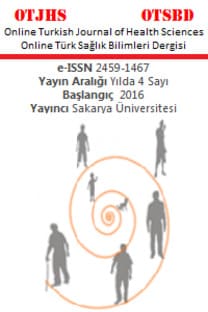Farklı Renk Kompomerlerin Polimerizasyon Esnasında Direkt Işık Geçirgenliklerinin Değerlendirilmesi: Radyometrik Bir Çalışma
Işık geçirgenliği, Kompomer, Radyometre
Evaluation of Direct Light Transmittance of Different Color Compomers during Polymerization: A Radiometric Study
Light Transmittance, Compomer, Radiometer,
___
- Nicholson JW. Polyacid modified composite resins ("compomers") and their use in clinical dentistry. Dent. Mater. 2006;23(5):615–622. doi: 10.1016/j.dental.2006.05.002
- Eliades G, Kakaboura A, Palaghias G. Acid–base reaction and fluoride release profiles in visible light-cured polyacid-modified composite restoratives (compomers). Dent. Mater. 1998;14(1):57–63. doi: 10.1016/s0109-5641(98)00010-4
- Janda R, Roulet JF, Latta M, Steffin G, Rüttermann S. Color stability of resin-based filling materials after aging when cured with plasma or halogen light. Eur. J. Oral Sci. 2005;113(3):251-257. doi: 10.1111/j.1600-0722.2005.00217.x
- Tokay U, Koyutürk AE, Aksoy A, Özmen B. Do the monomers release from the composite resins after artificial aging. Microsc. Res. Tech. 2015;78(4):255‐259. doi: 10.1002/jemt.22468
- Rueggeberg FA, Caughman WF, Curtis JW. Effect of light intensity and exposure duration on cure of resin composite. Oper. Dent. 1994;19(1):26-32.
- Leonard DL, Charlton DG, Roberts HW, Cohen ME. Polymerization efficiency of LED curing lights. J. Esthet. Restor. Dent. 2002;14(5):286-295. doi: 10.1111/j.1708-8240.2002.tb00524.x
- Tsai PC, Meyers IA, Walsh LJ. Depth of cure and surface microhardness of composite resin cured with blue LED curing lights. Dent. Mater. 2004;20(4):364-369. doi: 10.1016/S0109-5641(03)00130-1
- Millis RW, Uhl A, Jandt KD. Optical power outputs, spectra and dental composite depths of cure,obtained with blue light emmitting diode (LED) and halogen light curing units(LCUs). Br. Dent. J. 2002;193(8):459-462. doi: 10.1038/sj.bdj.4801597
- Bala O, Üçtaşlı MB, Arısu HD. Kompozit rezinlerin polimerizasyon derinliği üzerine farklı polimerizasyon teknikleri ve rengin etkileri. G.Ü. Diş Hek. Fak. Derg. 2008;25(3):7-14.
- Bağış HY, Gür S, Özçelik B, Bağış B. Estetik materyallerin direkt ışık geçirgenlikleri. A.Ü. Diş. Hek. Fak. Derg. 2004;31(1):1-7.
- Leloup G, Holvoet PE, Bebelman S, Devaux J. Raman Scattering determination of the depth of cure of light-activated composites: influence of different clinically relevant parameters. J. Oral Rehabil. 2002;29(6):510-515. doi:10.1046/j.1365-2842.2002.00889.x
- Rode KM, de Freitas PM, Lloret PR, Powell LG, Turbino ML. Micro-hardness evaluation of a micro-hybrid composite resin light cured with halogen light, light-emitting diode and argon ion laser. Lasers Med. Sci. 2009;24(1):87-92. doi: 10.1007/s10103-007-0527-x
- Koupis NS, Vercruysse CW, Marks LA, Mertens LC, Verbeeck RM. Curing depth of (polyacid-modified) composite resins determined by scraping and a penetrometer. Dent. Mater. 2004;20(10):908–914. doi: 10.1016/j.dental.2004.01.001
- Bezgin T, Özer L, Tulga Öz F, Özkan P. Effect of toothbrushing on color changes of esthetic restorative materials. J. Esthet. Restor. Dent. 2015;27(1):65-73. doi: 10.1111/jerd.12136
- Çoğulu D, Ersin N, Ertuğrul F. Renk, Işınlama mesafesi ve ışınlama süresinin iki farklı kompomer materyalinin yüzey sertliği üzerine etkisinin incelenmesi. E.Ü. Diş Hek. Fak. Derg. 2007;28:187-192.
- Tabassum S, Hameed MH, Khan FR. Comparison of the depth of cure of flowable composites polymerized at variable increment thicknesses and voltages: an in vitro study. Contemp. Clin. Dent. 2019;10(2):220-225. doi: 10.4103/ccd.ccd_635_18
- Yap AU. Effectiveness of polymerization in composite restoratives claiming bulk placement: impact of cavity depth and exposure time. Oper. Dent. 2000;25(2):113-120.
- Mohamed-Tahir MA, Tan HY, Woo AA, Yap AU. Effects of pH on the microhardness of resin-based restorative materials. Oper. Dent. 2005;30(5):661-666.
- Ilie N, Bucuta S, Draenert M. Bulk-fill resin-based composites: an in vitro assessment of their mechanical performance. Oper. Dent. 2013;38(6):618-625. doi: 10.2341/12-395-L
- Ilie N, Stark K. Curing behaviour of high-viscosity bulk-fill composites. J. Dent. 2014;42(8):977-985. doi: 10.1016/j.jdent.2014.05.012
- Örtengren U, Wellendorf H, Karlsson S, Ruyter I. Water sorption and solubility of dental composites and identification of monomers released in an aqueous environment. J. Oral Rehabil. 2001;28(12):1106-1115. doi:10.1046/j.1365-2842.2001.00802.x
- Vaubert V, Moon P, Love B. Extractable free monomers from self‐cured dental sealants resulting from dispensing errors. J. Biomed. Mater. Res. 1999;48(1):5-8.
- Aguiar FH, Lazzari CR, Lima DA, Ambrosano GM, Lovadino JR. Effect of light curing tip distance and resin shade on microhardness of a hybrid resin composite. Braz. Oral. Res. 2005;19(4):302-306. doi: 10.1590/s1806-83242005000400012
- Yamanel K, Baltacıoğlu İ, Bağış YH. Opak renkli kompozit rezinin ışık geçirgenliğine etkisi. A.Ü. Diş Hek. Fak. Derg. 2009;36(3):131-135.
- Bulucu B. Kompozit dolgu maddelerinin klinik kullanımında göz önünde bulundurulması gereken kriterler. Ata. Üni. Diş Hek. Fak. Derg. 1997;7(1):108-111.
- Knobloch LA, Kerby RE, Clelland N, Lee J. Hardness and degree of conversion of posterior packable composites. Oper. Dent. 2004;29(6):642-649.
- Fondriest J. Shade matching in restorative dentistry: the science and strategies. Int. J. Periodontics Restorative Dent. 2003;23(5):467-479.
- Kawaguchi M, Fukushima T, Miyazaki K. The relationship between cure depth and transmission coefficient of visible-light-activated resin composites. J. Dent. Res. 1994;73(2):516–521. doi: 10.1177/00220345940730020601
- Yu B, Lee YK. Influence of color parameters of resin composites on their translucency. Dent. Mat. 2008;24(9):1236-1242. doi: 10.1016/j.dental.2008.01.016
- ISSN: 2459-1467
- Yayın Aralığı: Yılda 4 Sayı
- Başlangıç: 2016
- Yayıncı: Oğuz KARABAY
Kardiyopulmoner Bypass'ın Hemogram Parametreleri Üzerine Etkisi
Bişar AMAÇ, AYDEMİR KOÇARSLAN, Mehmet Salih AYDIN, Nazım KANKILIÇ, Mahmut PADAK, Reşat DİKME
Haller Hücreleri ve Schneiderian Membran Kalınlığı Arasındaki İlişkinin Analizi
Emrah DİLAVER, Aslıhan AKBULUT, Cagri DELILBASI
Yetişkinlerde Gıda Etiketi Okuma Bilgi Düzeyi ile Davranışa Geçirme Arasındaki İlişki
Mervenur GÖKÇEN, Aylin SEYLAM KÜŞÜMLER
Bilal ÖZMEN, Zeynep KAYA, Hatice Zehra BODUR GÜNEY
Eve Geçiş: Preterm Ebeveyn Ölçeği'nin Türkçe Geçerlik ve Güvenirlik Çalışması
Hamide ZENGİN, Öznur TİRKAKİ, Nursan ÇINAR
Yoğun Bakım Ünitelerinde Çalışan Hemşirelerin Tükenmişlik Düzeyinin Belirlenmesi
Celalettin KORKMAZ, Soner DEMİRBAŞ, Hülya VATANSEV
Fatih VAROL, Oznur ESER, Günay KAPLAN, Aysun BOGA, Şirin GÜVEN, Betul Zehra PIRDAL
Akdeniz Diyetine Uyum ve Üniversite Öğrencilerinin Bazı Antropometrik Özellikleri
